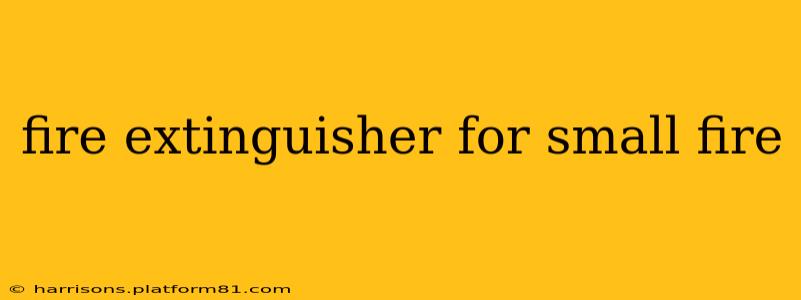Small fires can quickly escalate into major emergencies, causing significant property damage and posing serious risks to life and safety. Knowing how to effectively extinguish a small fire, and having the right fire extinguisher on hand, is crucial. This guide will walk you through selecting the appropriate fire extinguisher for your home or workplace, explaining the different types available and their best uses. We'll also address common questions surrounding fire extinguisher use and maintenance.
What Type of Fire Extinguisher is Best for Small Fires?
This depends entirely on the type of small fire you're facing. Fires are classified into different categories based on the fuel source:
- Class A: Ordinary combustibles like wood, paper, cloth, and some plastics.
- Class B: Flammable liquids like gasoline, oil, grease, and solvents.
- Class C: Electrical fires involving energized electrical equipment.
- Class D: Combustible metals like magnesium, titanium, and sodium.
- Class K: Cooking oils and greases.
The most versatile extinguisher for small fires in a home setting is usually a ABC extinguisher. This single unit can tackle Class A, B, and C fires, offering comprehensive protection. However, for specific situations, more specialized extinguishers might be necessary. For example, a kitchen should ideally have a Class K extinguisher to handle grease fires effectively.
What Size Fire Extinguisher Do I Need for a Small Fire?
The size of the extinguisher needed depends on the potential size of the fire and the area being protected. For small residential fires, a 2A10BC or 5B:C extinguisher is often sufficient. The numbers represent the extinguisher's rating—higher numbers indicate a greater fire-suppressing capacity. Always check local fire codes and regulations for specific requirements. It's better to err on the side of caution and choose a slightly larger extinguisher than to underestimate the potential fire's size.
How to Use a Fire Extinguisher for Small Fires (PASS Method)
Remember the acronym PASS:
- Pull the pin.
- Aim at the base of the fire.
- Squeeze the lever.
- Sweep from side to side.
Never attempt to fight a fire if it's spreading rapidly, becoming too large, or endangering your safety. Your primary concern should always be your personal well-being. Evacuate immediately and call emergency services if the fire is beyond your control.
Can I Use a Fire Extinguisher on Different Types of Fires?
No, using the wrong type of extinguisher on a specific class of fire can be dangerous and ineffective. It’s crucial to choose an extinguisher that's rated for the type of fire you're facing. For instance, using a water-based extinguisher on a grease fire can cause the flames to spread dramatically.
How Often Should I Inspect My Fire Extinguisher?
Regular inspection is critical for ensuring your extinguisher is ready for use. Visually inspect your extinguisher monthly, checking for any signs of damage, corrosion, or leaks. Have a professional inspect and service your extinguisher annually to ensure it's properly charged and maintained.
Where Should I Place Fire Extinguishers in My Home?
Strategically position fire extinguishers in easily accessible locations, away from potential fire hazards. Keep them near exits, in kitchens, garages, and other high-risk areas. Ensure everyone in your household knows their location and how to use them.
What Should I Do After Using a Fire Extinguisher?
After using a fire extinguisher, immediately call emergency services, even if you believe you've extinguished the fire completely. Report the incident to your insurance company and have the extinguisher professionally inspected and recharged or replaced.
By understanding the different types of fire extinguishers, their proper use, and regular maintenance practices, you can significantly improve your home or workplace safety and effectively manage small fires. Remember, prevention is key—ensure you have working smoke detectors and practice fire safety procedures regularly.
